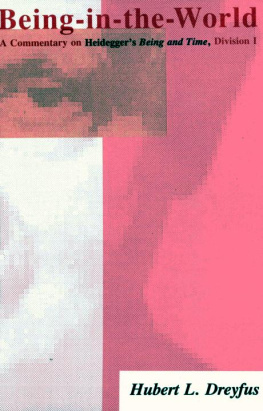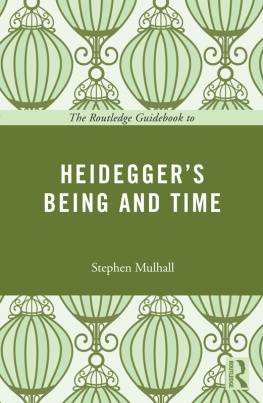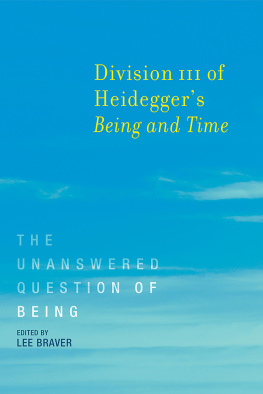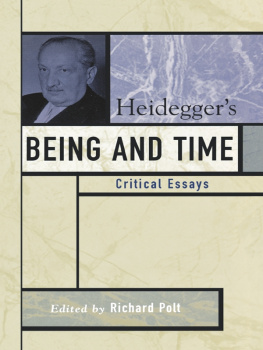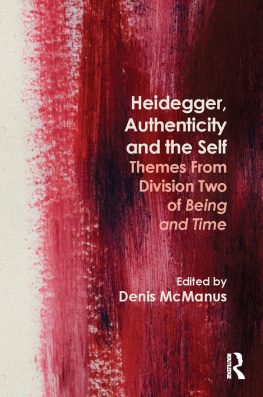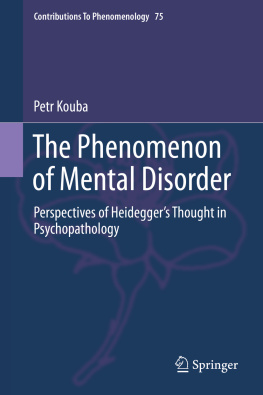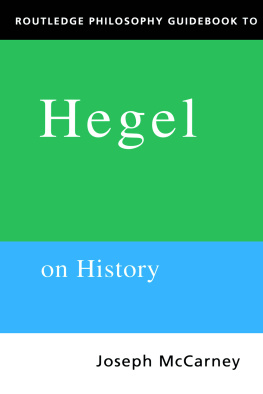A Commentary on Heidegger's Being and Time, Division I
Hubert L.Dreyfus



Appendix: Klerkegaard, Division II, and Later Heidegger

This commentary has been circulating in gradually changing versions for over twenty years. It started in 1968 as a set of "Fybate Lecture Notes" transcribed from my course on Being and Ti me at the University of California, Berkeley. In 1975 1 started circulating my updated lecture notes to students and anyone else who was interested. For a decade thereafter I revised the notes each year, incorporating and responding to what I learned from my students and teaching assistants. By 1985 there were so many requests for "The Heidegger Transcripts" that I was encouraged to transform them into a book. The first draft of the book was finished in time for a 1988 NEH Summer Institute held at the University of California, Santa Cruz. On the basis of what I learned from colleagues and participants there and during the following summer, when I taught a course on Being and Time at the University of Frankfurt, I did one final revision for this MIT Press edition.
About all that has stayed constant over twenty years of revising has been my decision to limit the notes to Division I of Part One of Being and Time. I still consider this the most original and important section of the work, for it is in Division I that Heidegger works out his account of being-in-the-world and uses it to ground a profound critique of traditional ontology and epistemology. Division II of Part One, which makes up the rest of what we have of Heidegger' s proposed two-part book (Division III of Part One and all of Part Two were never published), divides into two somewhat independent enterprises. First, there is the "existentialist" side of Heidegger' s thought, which focuses on anxiety, death, guilt, and resoluteness and which, although highly influential on its own and in its Sartrian version in Being and Nothingness, was, for good reasons, later abandoned by Heidegger himself. And second, there is the laying out of the temporality of human being and of the world, and the ground ing of both of these in a more originary temporality whose past, present, and future dimensions are not to be thought ofas successive.
Although the chapters on originary temporality are an essential part of Heidegger's project, his account leads him so far from the phenomenon of everyday temporality that I did not feel I could give a satisfactory interpretation of the material. Moreover, the whole of Division II seemed to me much less carefully worked out than Division I and, indeed, to have some errors so serious as to block any consistent reading. (I subsequently learned that when Heidegger was up for the equivalent of tenure, he submitted only Division I for publication, but the Ministry of Education considered it "insufficient." He agreed, in exchange for tenure, to publish a hastily finished version of Division II.)
In the end, thanks to two of my former students, the book has turned out somewhat differently than I had originally planned. Jane Rubin, who was then teaching the Kierkegaard course at Berkeley, agreed to collaborate with me on an article on Kierkegaard's influence on early Heidegger. At roughly the same time, Berkeleywenton the semester system, atwhich time I decided to add Division II to my Being and Time course. Under these conditions I became more and more involved in sorting out the existentialist side of Heidegger, and our article grew into the appendix of this book.
With regard to the very difficult chapters on time, I was saved by William Blattner, who, after working on Heidegger as an undergraduate at Berkeley, wrote his doctoral dissertation with John Haugeland at Pittsburgh on temporality in Kant and Heidegger. His account of temporality in Beingand Timepinpoints and corrects Heidegger's confusions and makes sense of even the most difficult passages. When Blattner publishes his work, it will be an important contribution to an understanding of Heidegger on time and can be thought of as completing this commentary.
Another event that required radically revising the transcripts was the posthumous publication of Heidegger's lecture courses, including those from the years immediately preceding and following the publication of Being and Time in 1927. History of the Concept of Time (1925), The Basic Problems of Phenomenology (1927), and The Metaphysical Foundations of Logic (1928) cast floods of new light on Heidegger's magnum opus. Many passages that are unintelligible in Being and Time are spelled out in clear and simple terms in the lectures. These new publications also confirmed a hypothesis John Haugeland and I had made in 1978 that Being and Time could be understood as a systematic critique of Husserl's phenomenology, even though Husserl and his basic concept, intentionality, are hardly mentioned in the book. The appearance of Basic Problems, which explicitly undertakes "the task of... interpreting more radically the phenomena of intentionality and transcendence" seemed a confirmation ofour approach. It also justified my emphasis on the nonmentalistic approach to intentionality in Being and Time, which, thanks to the constant friendly opposition of John Searle, already figured prominently in my commentary.
When Being and Time was published in 1927, it was immediately recognized as a classic. Perhaps for this reason Heidegger never made any substantive changes to the text, although he did make small stylistic changes in the fourteen subsequent reprintings. He also kept several copies of the book in which he made notes correcting passages that had been or could be misunderstood and criticizing the book's substantive claims from the perspective of his later thought. (Heidegger's writings are divided by him into two periods: those dating roughly from before 1930, and those written from 1930 on.)
Quotations from Being and Time in this book are followed by two sets of page numbers; the first (in parentheses) refers to a page of the standard English translation, the second (in brackets) to a page of the standard German. When I quote from Heidegger's marginal notes, I cite the page number from Sein & Zeit in the Gesamtausgabe [Collected works] edition in braces. Chapters in Being and Tinw are cited with roman numerals, chapters in this book with arabic numerals (and a lower-case c for clarity).
Being and Time is notoriously hard to translate. Heidegger was determined to avoid the mistaken ontology built into traditional philosophical terms, but he was also convinced that ordinary language was inevitably misleading and had contributed to and reciprocally been corrupted by philosophy. He therefore made up many of his own technical terms. Heidegger's translators have struggled with this problem with varying degrees of success. In the Macquarrie-Robinson translation of Being and Time, which is the only one in English, Heidegger's prose is generally well rendered, but many of the technical terms have been translated into English terms that either lack the connotations Heidegger is relying on to get his point across or, worse, have just the connotations Heidegger is trying to avoid. In some cases the translators of the three volumes of lectures from the period of Being and Time have come up with better terms, but their diverse ideas only further complicate matters when one needs to assemble quotations from all four texts.

